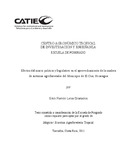| dc.contributor.advisor | Detlefsen, Guillermo | es_ES |
| dc.contributor.advisor | Ibrahim, Muhammad | es_ES |
| dc.contributor.author | Leiva Granados, Erick R. | |
| dc.date.accessioned | 2014-10-20T04:48:41Z | |
| dc.date.available | 2014-10-20T04:48:41Z | |
| dc.date.issued | 2011 | es_ES |
| dc.identifier.uri | https://repositorio.catie.ac.cr/handle/11554/4909 | |
| dc.description | Tesis (Maestría) -- CATIE, Turrialba (Costa Rica), 2011 | es_ES |
| dc.description.abstract | El presente estudio se realizó en el municipio de El Cuá, Nicaragua, con el objetivo de evaluar el efecto de la legislación forestal nicaragüense en el manejo y aprovechamiento de madera en sistemas agroforestales (SAF). En los SAF del presente estudio se encontraron 118 especies arbóreas de las cuales el 41% (48) son de uso maderable. Estos SAF presentan volúmenes comerciales de 33.45,19.95 y 16.49 m3/ha para cafe, cacao y potreros con arboles dispersos, respectivamente y de 28.69 m3/Km para cercas vivas. Las especies maderables mas comunes son: laurel (Cordia alliodora), macuelizo (Tabebuia rosea), nogal (Juglans olanchana), chaperno (Albizia adinocephala), cedro (Ceclrela odorata) y aguacate canelo (Cinnamomum costaricanum). Cabe resaltar que el volumen maderable más alto encontrado en las fincas agropecuarias del presente estudio fue el de los bosques riparios (101.34 m3/ha). Sin embargo, debido a que dicha madera no se puede aprovechar por ley, su volumen comercial no cuenta como potencial maderable en la zona. Solamente cuenta para fines ecosistémicos. La legislación forestal que se aplica en el municipio de El Cuá, como en el resto del país es amplia. Las numerosas normativas (15) generan ambigüedades y contradicciones entre ellas, incrementando costos (US 34.25 m-3) y tiempo invertido en la solicitud de los permisos de aprovechamiento forestal (al menos 37 días). Con base en lo anterior y a la revisión bibliográfica de las legislaciones forestales de otros países de Centroamérica, se elaboró una propuesta de normativa simplificada para el manejo y aprovechamiento maderable en SAF, orientada a la reducción de trámites y de costos económicos, asi como para garantizar la sostenibilidad del aprovechamiento forestal. This study was conducted in the municipality of El Cua, Nicaragua, with the aim to evaluate the effect of Nicaraguan Forestry Laws on the management and harvesting of timber in agro-forestry systeMON (AFS). In the AFS of this study were found 118 tree species of which 41 % (48) are commonly used timber. These AFS have commercial volumes of 33.45, 19.95 and 16.49 m3/ha for coffee, cocoa and pastures with scattered trees respectively, and of 28.69 m3/km for live fences. The most common timber species found are: laurel (Cordia alliodora), macuelizo (Tabebuia rosea), nogal (Juglans olanchana), chaperno (Albizia adinocephala), cedro (Cedrela odorata) and aguacate canelo (Cinnamomum costaricanum). It should be emphasized that the highest timber volume found in the farMON of this study was that of the riparian forests (101.34 m3/ha). However, since this wood cannot be tapped by law, its commercial volume cannot be considered as potential timber in the area. This AFS only serves for ecosystem purposes. The forest legislation that is applied in the municipality of EI Cua, as in the rest of the country is wide in general terMON. The numerous regulations (IS) generate ambiguities and contradictions between them, increasing costs (US 34.25 m3) and invested time in the application of the forestry permits (at least 37 days). Based on the above and the literature review of the forest legislations of other Central America countries, a simplified regulatory proposal for the management and timber harvesting in AFS was developed, aimed at the reduction of paperwork, economic costs and ensure the sustainability of the forest harvesting. | es_ES |
| dc.description.abstract | This study was conducted in the municipality of El Cua, Nicaragua, with the aim to evaluate the effect of Nicaraguan Forestry Laws on the management and harvesting of timber in agro-forestry systeMON (AFS). In the AFS of this study were found 118 tree species of which 41 % (48) are commonly used timber. These AFS have commercial volumes of 33.45, 19.95 and 16.49 m3/ha for coffee, cocoa and pastures with scattered trees respectively, and of 28.69 m3/km for live fences. The most common timber species found are: laurel (Cordia alliodora), macuelizo (Tabebuia rosea), nogal (Juglans olanchana), chaperno (Albizia adinocephala), cedro (Cedrela odorata) and aguacate canelo (Cinnamomum costaricanum). It should be emphasized that the highest timber volume found in the farMON of this study was that of the riparian forests (101.34 m3/ha). However, since this wood cannot be tapped by law, its commercial volume cannot be considered as potential timber in the area. This AFS only serves for ecosystem purposes. The forest legislation that is applied in the municipality of EI Cua, as in the rest of the country is wide in general terMON. The numerous regulations (IS) generate ambiguities and contradictions between them, increasing costs (US 34.25 m3) and invested time in the application of the forestry permits (at least 37 days). Based on the above and the literature review of the forest legislations of other Central America countries, a simplified regulatory proposal for the management and timber harvesting in AFS was developed, aimed at the reduction of paperwork, economic costs and ensure the sustainability of the forest harvesting. | en_EN |
| dc.publisher | Centro Agronómico Tropical de Investigación y Enseñanza (CATIE), Turrialba (Costa Rica) | es_ES |
| dc.rights | info:eu-repo/semantics/openAccess | |
| dc.subject | MADERA | |
| dc.subject | APROVECHAMIENTO DE LA MADERA | |
| dc.subject | ARBOLES | |
| dc.subject | REGENERACION NATURAL | |
| dc.subject | AGROFORESTERIA | |
| dc.subject | POLITICA FORESTAL | |
| dc.subject | LEGISLACION | |
| dc.subject | NICARAGUA | |
| dc.title | Efectos del marco político y legislativo en el aprovechamiento de la madera de sistemas agroforestales del Municipio de El Cuá, Nicaragua | es_ES |
| dc.type | Tesis de maestría | es_ES |
| dc.identifier.publication | Turrialba (Costa Rica) | es_ES |


